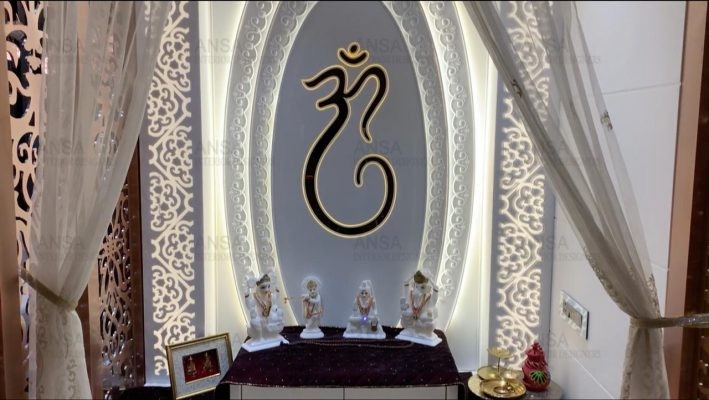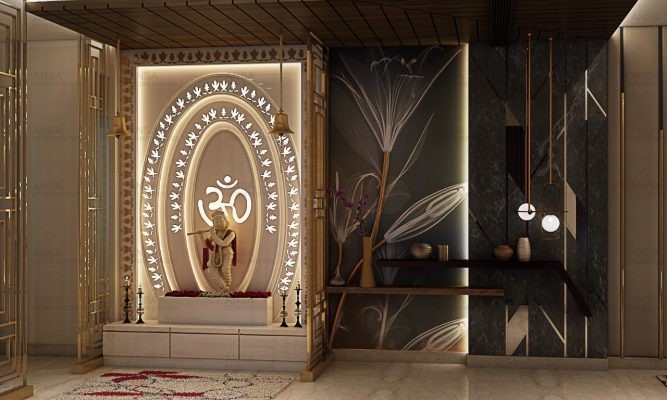Indian culture is famous worldwide for its rich heritage replete with tales of culture and tradition. Faith and religion form an integral part of our everyday life, which is why majority of our households have at least one dedicated corner to worship God. In Hindu tradition, it is very common to have a mandir to pray to different deities. As one of the top interior designers in Delhi, Ansa Interiors is fully aware of the cultural sensitivities of our clients. We take pride in delivering exceptional mandir interior designing services by incorporating the personal tastes and preferences of our esteemed patrons.
-
The perfect blend of modernity with tradition
All our mandir interior designing projects are focused on finding that perfect amalgam of modernity and tradition. While reverence to Gods and Goddesses has always been associated with a traditional set-up, making it modern enough to complement the rest of the house is something we pay utmost attention to.
This can be achieved through the use of elegant wall accents and textures centered amidst a basic glass panel.
To have that haloed vibe, you can opt for beautiful lights around the idols; and you have a winner at your hands!
-
Choose the right material
When it comes to mandir set-ups for the home, the market has myriad varieties of material available. Wood, marble, steel, and finished iron are some examples. The choice of material will depend, to a large extent, on the color scheme of the walls. If the space has neutral hued walls, a wooden mandir will be a great choice. It adds depth to the room and also helps in creating and maintaining that traditional aura. For a more sophisticated and modern look where the walls are bit darker in color, a marble-make mandir will do wonders to the overall feel of the space. Polished marble works best here. Wood and marble are also appropriate materials when it comes to handling the different worship elements such as incense sticks, coconuts, pooja thalis, and the idols themselves.
-
Light it up properly
Talking of mandir interior designing, it is not just the amount and nature of lighting that matters. Remember, the vibe is of utmost importance here. With this in mind, we recommend our clients to go for golden, orange or yellow colored lighting. This type of lighting helps to ensure that the space is beaming with a consistent glow and positivity. It also helps make your mandir inviting for family members and friends wherein they can come and spend more time meditating on the name of God. Once we start working on your project, you will actually see what a significant difference this kind of lighting makes.
-
The evergreen stones and carvings
You can make your mandir stand the test of time through the use of evergreen elements of traditional interior design- stones and intricate carvings. Stones can be incorporated in a couple of ways. You could go for elegant marble flooring, and also get idols made with precious stones which are oh-so-perfect for this kind of a space in your home! As for the carvings, they can be added through carved wooden doors and panels which separate the mandir from the rest of the house. As this is a place of faith and worship, we ensure that the sanctity is maintained without any compromise on the aesthetics.
-
Add religious imprints
A mandir calls for visual elements that reinforce the belief that it is indeed a place that belongs to the Almighty. In Hindu tradition, there are a host of elements that can be used to achieve this. Om, and Swastik are highly common choices. You could also go for a religious hymn from the scriptures and get it imprinted on the main (central) wall of the mandir. As a design recommendation, such imprints should be placed adjacent to the idols to create a holistic look and appeal. Humans remember visuals really well and these imprints are a great way to teach and showcase our religious traditions to our children.
-
Accessorize in style
All said and done, home mandir interior designing cannot be complete without the use of beautiful accessories. To begin with, fresh flowers can be a great addition to the space. They not only emanate fragrance, but are in perfect harmony with the vibes you would associate with a mandir.
You could make use of a different color on a daily basis to make your mandir look and feel vibrant.
Besides flowers, decorative pooja thalis are another must have in your home mandir.
The market also has a variety of earthen lamps as well as modern diyas available in different colours with decorative accents.
Then, you could make use of incense stick holders that are elegant and classy.
You can also add elegant stools for seating purposes in the mandir. Wooden stools with intricate designs are a great addition.
As you have seen by now, there is no dearth of accessories for a home mandir. Just pick and choose what goes best with your set-up.
While designing the mandir, it would be ideal to pay attention to few small but significant things. Firstly, there should be an electrical point in the vicinity so that you can light up the space brightly during festivals such as Diwali. Also ensure that you steer clear of any clutter or bins near the mandir area, for obvious reasons. All safety precautions should be taken while lighting diyas or incense sticks; adequate ventilation helps a lot.
We take pride in delivering mandir interior designing services for not only big homes, but also apartments and smaller spaces; this makes us the trusted choice among Delhi interior designers. For such spaces, we usually make custom cabinets that can be put in a corner solely for the purpose of prayer and worship. We lay emphasis on creating cabinets that match the rest of the interior for a uniform overall look. So no matter the size of your home, we will help you create an appropriate sacred corner where you can pray to God whenever you wish to. Call Ansa Interiors today for a truly divine mandir interior designing experience.



